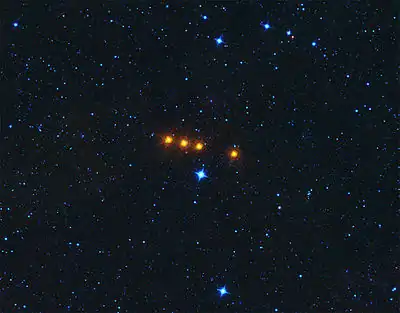31 Euphrosyne
Euphrosyne (minor planet designation: 31 Euphrosyne) is a very young asteroid, and the 9th- or 10th-largest in the asteroid belt. It was discovered by James Ferguson on September 1, 1854, the first asteroid found from North America. It is named after Euphrosyne, one of the Charites in Greek mythology. In 2019 a small companion was discovered. It is the third-roundest known asteroid (after 1 Ceres and 10 Hygiea); this is thought to be due to having re-accreted after being disrupted by a collision, and it is not close to hydrostatic equilibrium.[4]
 Three-dimensional model of 31 Euphrosyne created based on light-curve | |
| Discovery | |
|---|---|
| Discovered by | J. Ferguson |
| Discovery date | September 1, 1854 |
| Designations | |
| (31) Euphrosyne | |
| Pronunciation | /juːˈfrɒsɪniː/[1] |
Named after | Εὐφροσύνη Eyphrosynē |
| A907 GP; A918 GB | |
| Main belt | |
| Adjectives | Euphrosynean /juːfrɒsɪˈniːən/[2] |
| Orbital characteristics[3] | |
| Epoch April 27, 2019 (JD 2458600.5) | |
| Aphelion | 3.8523 AU (576.296 Gm) |
| Perihelion | 2.4585 AU (367.786 Gm) |
| 3.1554 AU (472.041 Gm) | |
| Eccentricity | 0.2209 |
| 5.61 yr (2041.585 d) | |
| 87.1671° | |
| Inclination | 26.3033° |
| 31.1186° | |
| 61.4704° | |
| Known satellites | 1 |
| Physical characteristics | |
| Dimensions | 267.1±2.6 km (IRAS)[3] 268±6 km[4] (294±6) × (280±10) × (248±6) km[4] |
| Mass | (1.7±0.3)×1019 kg[4] |
Mean density | 1.66±0.24 g/cm3[4] |
| 0.230400 d (5.529595 h)[4] | |
| 0.0543[5] | |
| C[3][6] | |
| 10.16[7] to 13.61 | |
| 6.74[3] | |
Observations
Euphrosyne is a fairly dark body near the belt's outer edge. Consequently, Euphrosyne is never visible with binoculars, having a maximum apparent magnitude at the best possible opposition of around +10.2 (as in November 2011), which is fainter than any of the thirty asteroids previously discovered.[8]
Euphrosyne has a high orbital inclination and eccentricity having nodes near perihelion and aphelion, Euphrosyne's perihelion lies at the northernmost point of its orbit. During perihelic oppositions, Euphrosyne is very high in the sky from northern latitudes and invisible from southern countries such as New Zealand and Chile.
Surface
Euphrosyne is a C-type asteroid with a primitive surface possibly covered by thick ejection blanket from the collision that created its moon and collisional family. There are no deep basins. Any craters larger than 40 km in diameter must have flat floors to not be visible in the VLT images, consistent with an icy C-type composition. The lack of craters could also be due to the young age of the surface.[4]
Mass and density
The discovery of its satellite enabled the first accurate measure of Euphrosyne's mass in 2020, at (1.7±0.3)×1019 kg, and thus a density of 1.7±0.2 g/cm3. The low density suggests that Euphrosyne is half water ice if internal porosity is 20%.[4]
Satellite and family
| Discovery | |
|---|---|
| Discovery date | 2019 March 15 |
| Designations | |
Designation | Euphrosyne I |
| Orbital characteristics[4] | |
| Epoch EQJ2000 | |
| 672±12 km | |
| Eccentricity | 0.043+0.041 −0.014 |
| 1.209±0.001 days | |
| Inclination | 1.4°±0.5° |
| 80.1°±9.3° | |
| 135.2°±13.5° | |
| Physical characteristics | |
Mean radius | 4.0±1.0 km |
Euphrosyne is the namesake of a complex family two thousand asteroids that share similar spectral properties and orbital elements. They are thought to have arisen from a recent collision approximately 280 million years ago.[4] All members have relatively high orbital inclinations.[9]
In 2019 a small satellite was discovered, likely resulting from the same collisional event that created the family. Preliminary orbit computations indicated an orbital period of approximately 1.2 days and a semi-major axis of 670 km. VLT images indicate that the moon is 4 km in diameter, assuming it has the same albedo as Euphrosyne.[4]
Gallery

References
- Noah Webster (1884) A Practical Dictionary of the English Language
- "Elia", The New-England Magazine, vol. IX, Oct. 1835, p. 236
- "JPL Small-Body Database Browser: 31 Euphrosyne" (2018-06-15 last obs). Retrieved 28 April 2019.
- Binary asteroid (31) Euphrosyne: Ice-rich and nearly spherical, 2020, arXiv:2007.08059
- Albedo table
- Astrometric and Geodetic Properties of Earth and the Solar System
- "Bright Minor Planets 2000". Minor Planet Center. Retrieved 23 May 2008.
- "Brightest asteroids". Archived from the original on 7 February 2012. Retrieved 6 August 2007.
- Novaković, Bojan; et al. (November 2011), "Families among high-inclination asteroids", Icarus, 216 (1), pp. 69–81, arXiv:1108.3740, Bibcode:2011Icar..216...69N, doi:10.1016/j.icarus.2011.08.016.
External links
- 31 Euphrosyne at AstDyS-2, Asteroids—Dynamic Site
- 31 Euphrosyne at the JPL Small-Body Database
